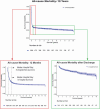Patient and Management Variables Associated With Survival After Postcardiotomy Extracorporeal Membrane Oxygenation in Adults: The PELS-1 Multicenter Cohort Study
- PMID: 37421269
- PMCID: PMC10382118
- DOI: 10.1161/JAHA.123.029609
Patient and Management Variables Associated With Survival After Postcardiotomy Extracorporeal Membrane Oxygenation in Adults: The PELS-1 Multicenter Cohort Study
Abstract
Background Extracorporeal membrane oxygenation (ECMO) has been increasingly used for postcardiotomy cardiogenic shock, but without a concomitant reduction in observed in-hospital mortality. Long-term outcomes are unknown. This study describes patients' characteristics, in-hospital outcome, and 10-year survival after postcardiotomy ECMO. Variables associated with in-hospital and postdischarge mortality are investigated and reported. Methods and Results The retrospective international multicenter observational PELS-1 (Postcardiotomy Extracorporeal Life Support) study includes data on adults requiring ECMO for postcardiotomy cardiogenic shock between 2000 and 2020 from 34 centers. Variables associated with mortality were estimated preoperatively, intraoperatively, during ECMO, and after the occurrence of any complications, and then analyzed at different time points during a patient's clinical course, through mixed Cox proportional hazards models containing fixed and random effects. Follow-up was established by institutional chart review or contacting patients. This analysis included 2058 patients (59% were men; median [interquartile range] age, 65.0 [55.0-72.0] years). In-hospital mortality was 60.5%. Independent variables associated with in-hospital mortality were age (hazard ratio [HR], 1.02 [95% CI, 1.01-1.02]) and preoperative cardiac arrest (HR, 1.41 [95% CI, 1.15-1.73]). In the subgroup of hospital survivors, the overall 1-, 2-, 5-, and 10-year survival rates were 89.5% (95% CI, 87.0%-92.0%), 85.4% (95% CI, 82.5%-88.3%), 76.4% (95% CI, 72.5%-80.5%), and 65.9% (95% CI, 60.3%-72.0%), respectively. Variables associated with postdischarge mortality included older age, atrial fibrillation, emergency surgery, type of surgery, postoperative acute kidney injury, and postoperative septic shock. Conclusions In adults, in-hospital mortality after postcardiotomy ECMO remains high; however, two-thirds of those who are discharged from hospital survive up to 10 years. Patient selection, intraoperative decisions, and ECMO management remain key variables associated with survival in this cohort. Registration URL: https://www.clinicaltrials.gov; Unique identifier: NCT03857217.
Keywords: acute heart failure; cardiac surgery; extracorporeal membrane oxygenation; mechanical circulatory support; postcardiotomy cardiogenic shock.
Figures
References
-
- Lorusso R, Whitman G, Milojevic M, Raffa G, McMullan DM, Boeken U, Haft J, Bermudez C, Shah A, D'Alessandro DA. 2020 EACTS/ELSO/STS/AATS expert consensus on post‐cardiotomy extracorporeal life support in adult patients. J Thorac Cardiovasc Surg. 2021;161:1287–1331. doi: 10.1016/j.jtcvs.2020.09.045 - DOI - PubMed
-
- Lorusso R, Raffa GM, Alenizy K, Sluijpers N, Makhoul M, Brodie D, McMullan M, Wang IW, Meani P, MacLaren G, et al. Structured review of post‐cardiotomy extracorporeal membrane oxygenation: part 1‐adult patients. J Heart Lung Transplant. 2019;38:1125–1143. doi: 10.1016/j.healun.2019.08.014 - DOI - PMC - PubMed
-
- Meani P, Matteucci M, Jiritano F, Fina D, Panzeri F, Raffa GM, Kowalewski M, Morici N, Viola G, Sacco A, et al. Long‐term survival and major outcomes in post‐cardiotomy extracorporeal membrane oxygenation for adult patients in cardiogenic shock. Ann Cardiothorac Surg. 2019;8:116–122. doi: 10.21037/acs.2018.12.04 - DOI - PMC - PubMed
-
- Vallabhajosyula S, Arora S, Sakhuja A, Lahewala S, Kumar V, Shantha GPS, Egbe AC, Stulak JM, Gersh BJ, Gulati R, et al. Trends, predictors, and outcomes of temporary mechanical circulatory support for postcardiac surgery cardiogenic shock. Am J Cardiol. 2019;123:489–497. doi: 10.1016/j.amjcard.2018.10.029 - DOI - PubMed


